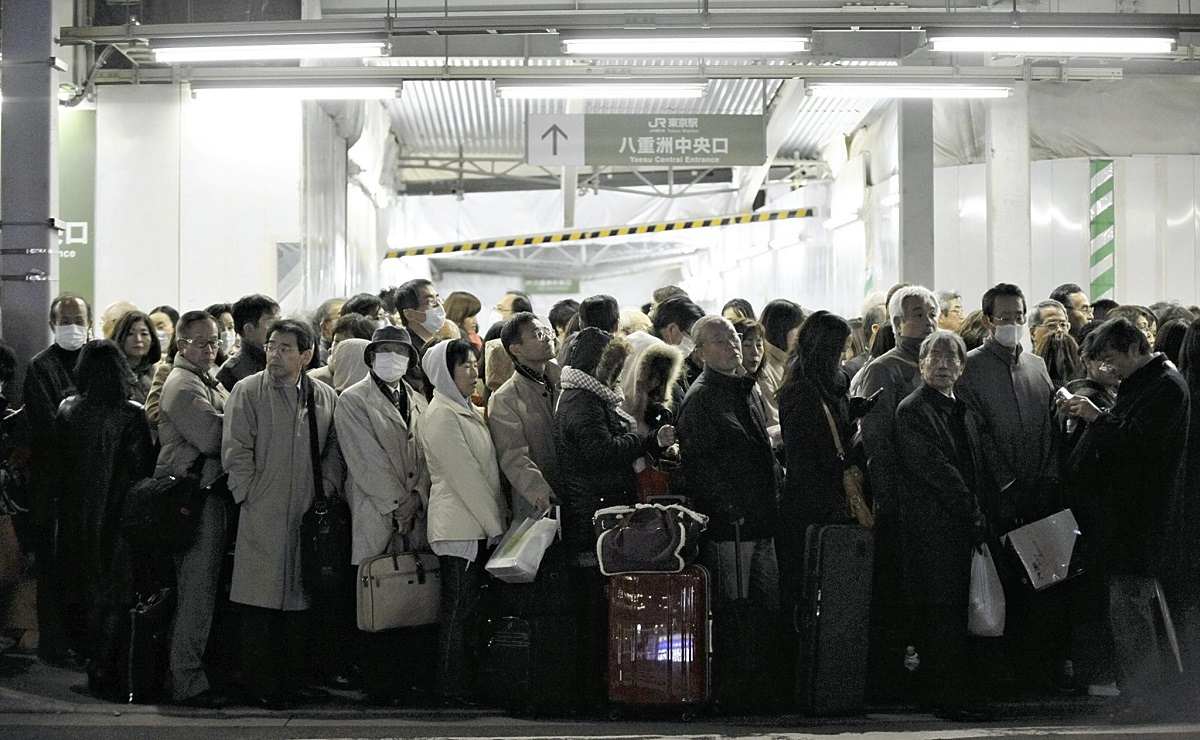
A crowd forms at JR Tokyo Station on March 11, 2011, after the Great East Japan Earthquake struck.
12:44 JST, September 3, 2023
TOKYO (Jiji Press) — Tokyo still lacks places to accommodate many people who would be left stranded if a huge earthquake hits the capital.
At the time of the 1923 Great Kanto Earthquake, which killed about 105,000 people in and around Tokyo, many people died in fires at places where they had evacuated, underlining the importance of ensuring safe evacuation in densely populated areas.
“Some 38,000 people died in less than an hour,” Nagoya University visiting professor Masayuki Takemura said, referring to the deadly fire in the former site of an army clothing depot in the current Sumida Ward, to which about 40,000 people had evacuated just after the temblor.
Police initially tried to guide evacuees across the Sumida River to the Ueno area but gave up the idea because fires prevented them from crossing bridges, Takemura said, adding that the police had to lead evacuees to the former depot site, which was vacant.
Then, evacuees in the site were surrounded by fire on all sides, and a large number of household goods they carried caught fire. Fire whirlwinds also occurred, boosting casualties further.
In the 1923 disaster, 90% of people who lost their lives were burned to death. Tokyo was crowded with wooden houses, and many people were using fire when the temblor struck just before noon.
In present-day Tokyo, buildings are far more resistant to fires and quakes. A major concern is that many people would be unable to return home if a huge quake occurs, because railroads and other transportation networks would be disrupted.
At the time of the March 2011 temblor, which rocked not only the Tohoku region but also Tokyo, 3.5 million people were stranded in the capital. Train stations and streets were flooded with people.
The Tokyo metropolitan government forecasts that 4.53 million people would be unable to return home in the event of a big quake directly beneath the metropolitan area, which is said to have a 70% chance of occurring within 30 years.
If there are so many stranded people, the risk of secondary disasters such as crowd crush is likely to increase.
At the time of the March 2011 disaster, many Tokyo municipalities, including Adachi Ward, opened up public facilities such as schools to stranded people and provided them with food and water.
Adachi Mayor Yayoi Kondo, however, is concerned. “If our ward sustains serious damage, it would be difficult to provide generous support,” she said.
Hoping to prevent secondary disasters, the metropolitan government obliges companies in the capital to make efforts to stockpile at least three days’ worth of food and other supplies to stop employees from trying to go home soon in the event of a big quake.
Supposing many companies in Tokyo make such preparations, the metropolitan government estimates the number of people who still would have no place to go at 660,000.
Municipalities in Tokyo are trying to secure temporary accommodation facilities for such people by concluding contracts with private business operators.
Particularly, municipalities pin high hopes on large-scale commercial complexes. In many big redevelopment projects in central Tokyo, plans for accommodating people stranded due to a disaster are included.
Real estate developer Mori Building Co., whose catchphrase is “develop a town where you can take refuge,” is prepared to accept a total of 10,000 people at its Roppongi Hills and Toranomon Hills complexes.
Mitsubishi Estate Co., which conducted rescue activities around Tokyo Station at the time of the Great Kanto Earthquake, is trying to create a platform to disseminate information on places accepting evacuees via digital bulletin boards and smartphones.
However, facilities for stranded people secured by the metropolitan government have a combined capacity of only about 440,000 people, less than 70% of the target.
A key problem that needs to be resolved to increase such facilities is the legal responsibility to compensate for injury or other damage incurred by stranded people during their stay in the facilities.
Some business operators stopped short of concluding contracts with Minato Ward because of the concern about the responsibility, a ward official said.
Another problem is fading public awareness of the metropolitan government’s ordinance seeking companies’ cooperation to stop employees from returning home. Last year, only 42% were aware of the ordinance, down from the 2016 peak of 68%.
Given the low awareness, there is a possibility that more people than expected would gather at train stations to go home. How to improve the public awareness about the importance of not trying to go home soon is also a key issue.
"Society" POPULAR ARTICLE
-

M4.9 Earthquake Hits Tokyo, Neighboring Prefectures
-

Israeli Tourists Refused Accommodation at Hotel in Japan’s Nagano Pref., Prompting Protest by Israeli Embassy and Probe by Prefecture
-

M7.5 Earthquake Hits Northern Japan; Tsunami Waves Observed in Hokkaido, Aomori and Iwate Prefectures
-

Tsukiji Market Urges Tourists to Avoid Visiting in Year-End
-

M5.7 Earthquake Hits Japan’s Kumamoto Pref., Measuring Upper 5 Intensity, No Tsunami Expected
JN ACCESS RANKING
-

Tokyo Economic Security Forum to Hold Inaugural Meeting Amid Tense Global Environment
-

Keidanren Chairman Yoshinobu Tsutsui Visits Kashiwazaki-Kariwa Nuclear Power Plant; Inspects New Emergency Safety System
-

Imports of Rare Earths from China Facing Delays, May Be Caused by Deterioration of Japan-China Relations
-

University of Tokyo Professor Discusses Japanese Economic Security in Interview Ahead of Forum
-

Japan Pulls out of Vietnam Nuclear Project, Complicating Hanoi’s Power Plans






















